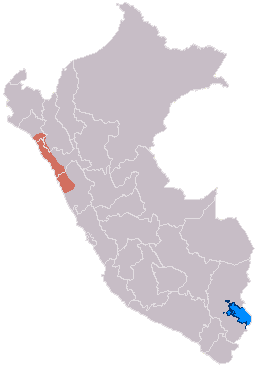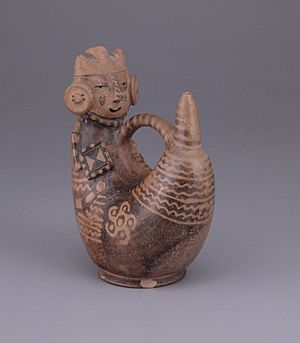Virú culture facts for kids

Map of the Virú culture
|
|
| Geographical range | Virú Valley |
|---|---|
| Period | Early Intermediate |
| Dates | c. 200 BCE - 600 CE |
| Preceded by | Chavin culture |
| Followed by | Wari culture |
The Virú culture (also called the Gallinazo) was an ancient civilization. It lived in the Virú Valley on the northwest coast of Peru. This was long before the Inca ruled.
The Virú culture started around 200 BCE. It marks the beginning of the Early Intermediate Period in Peru. This culture was mainly in the Virú Valley. It also spread to the Moche and Santa Valleys.
The Virú Valley is a narrow strip of land. The Andes Mountains are to its east. The Pacific Ocean is to its west. The main city of the Virú culture was called the Gallinazo Group site. This site was the most important center in the valley. It was likely where the leaders lived.
During this time, the Virú culture saw big changes. The population grew a lot. More land was used for farming. New irrigation canals were built. These canals helped bring water to the farms. The leaders also created a system to manage the valley. This system had four levels of administration.
Huaca Gallinazo: An Ancient City
Huaca Gallinazo is the biggest mound at the Gallinazo Group site. It is in the Virú Valley. People lived here from about 1 BCE to 700 CE. This area had many buildings. They included homes with several rooms and patios. These homes were used for living and storing things.
There were also different kinds of buildings. Some were simple houses. Others were grand homes with courtyards. Some mounds had large public buildings. This shows that powerful leaders lived here. They had the means to build huge projects. These projects were for public gatherings or special ceremonies.
The largest public building is in the middle of Huaca Gallinazo. This big structure has rooms filled with earth. Its columns are made of thousands of piled adobe bricks. These columns lean against each other. A tall platform and a terrace are part of this building. They face a wide plaza. This plaza was probably used for large public events and ceremonies.
Huaca Santa Clara: A Key Site
Excavations at Huaca Santa Clara teach us about the Moche and Gallinazo people. At first, experts thought this site was a Moche settlement. But studies of the buildings and pottery showed it was a busy Gallinazo community.
Huaca Santa Clara was a medium-sized administrative center. The Virú people built it on a small hill. This hill overlooks the center of the valley. It was an important place because it was the only way into the valley from the highlands. The main irrigation canals start in the highlands. This made the site very important for controlling water.
Huaca Santa Clara has many adobe platforms and terraces. They are built on the sides of Cerro Cementerio. There are four large buildings connected to each other. One is on top of the hill. The other three are on the terraces. Hundreds of pieces of decorative war maces were found here. These were ornaments for important buildings. They were only found at the top of the main structure. This shows their special use.
You could only enter Huaca Santa Clara from the valley through one of the three lower terraces. One terrace was very well preserved. It showed a complex system of paths. These paths guided visitors up the hill and into the building. A low bench and a special wall showed this was an important area. A passage in the northeast corner likely limited access to private rooms. One room had a large veranda. It offered a wide view of the valley. This room might have been used to watch over the eastern part of the hill. This showed power.
Large storage areas for farm products were also found at Huaca Santa Clara. These storage places were close to the homes of important people. They were also near special burials inside the buildings.
Many people believed the Moche had conquered the Virú Valley. They thought the Moche replaced the local leaders. But there is no proof of this at Huaca Santa Clara. The leaders at Huaca Santa Clara kept their power. They controlled the land, people, and the site itself. This lasted throughout the Early Intermediate Period.
Even without a direct takeover, the Moche had some control. Moche items were found in the elite areas. The relationship between these two powerful groups was not equal. But no one knows exactly how the Moche gained full control by 700 CE.
See also
 In Spanish: Cultura virú para niños
In Spanish: Cultura virú para niños


